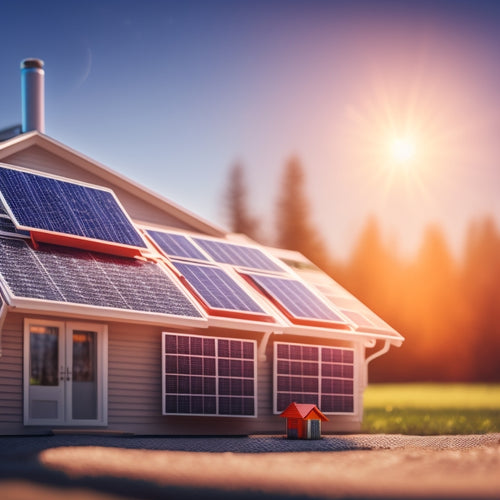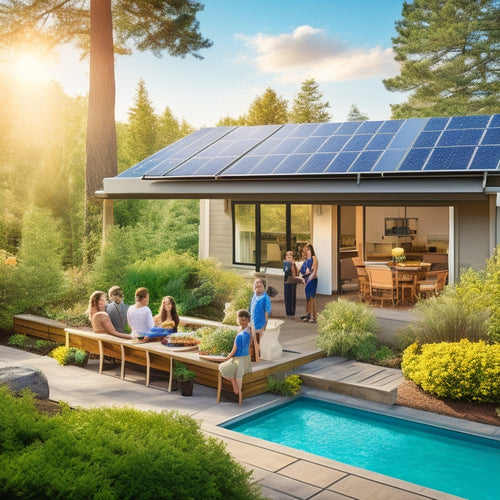
Free Your Home With Renewable Power Systems
Share
By shifting to renewable power systems, you can greatly reduce your reliance on the grid and save money on your energy bills. Solar power, in particular, can save you between $400 and $1,000 annually. To free your home, consider a hybrid system that combines grid-connected and energy storage benefits, allowing you to store excess energy generated during the day for nighttime use. With proper system sizing, installation, and maintenance, you can optimize your energy usage and reduce your carbon footprint. As you investigate renewable power systems, you'll uncover the possibilities for achieving energy independence and a more sustainable future.
Key Takeaways
- Renewable energy sources like solar, wind, and geothermal provide a sustainable alternative to traditional power systems, reducing reliance on fossil fuels.
- Solar power systems for homes can significantly lower energy costs and increase energy independence with proper system sizing and installation.
- Energy storage solutions like batteries enable homeowners to store excess energy generated during the day for nighttime use, further reducing grid reliance.
- Hybrid systems combining grid-connected and energy storage benefits allow homeowners to sell excess energy back to the grid and optimize energy usage.
- Microgrid systems provide complete energy independence, offering resilience against natural disasters and unpredictable outages with local energy generation and storage.
Renewable Energy Sources Explained
You're likely familiar with the term "renewable energy," but do you know what it really entails? Renewable energy refers to the utilization of natural resources that can be replenished over time, reducing our reliance on fossil fuels and minimizing our carbon footprint.
Biomass energy, derived from organic matter, is one such source. Solar power solutions offer reliable and renewable energy for off-grid locations, promoting energy independence. Geothermal heating, which exploits the Earth's internal heat, is another.
Hydropower advantages include reliability and scalability, while tidal energy utilizes the power of ocean tides. These renewable technologies promote energy efficiency and sustainable practices, ultimately reducing our dependence on non-renewable resources.
Benefits of Home Energy Independence
As you investigate renewable energy sources, you may wonder how to harness their power in your daily life. By shifting to home energy independence, you'll enjoy financial savings through reduced energy bills and potentially increased property value.
You'll also gain energy security, ensuring a reliable source of power even during outages. Furthermore, you'll reduce your environmental impact, contributing to a cleaner and healthier planet.
By achieving energy independence and community advancement, you'll also strengthen your local community and promote socioeconomic development. Additionally, off-grid solar systems provide a high degree of community resilience by adapting to changing circumstances and crises.
Government incentives and technological advancements make it more accessible and affordable than ever. This lifestyle benefit also promotes energy efficiency and encourages sustainable practices.
Solar Power Systems for Homes
You're considering solar power systems for your home, and it's crucial to understand the benefits of solar energy. By utilizing sunlight, you'll reduce your reliance on the grid and lower your energy bills.
Suitable system sizing is critical, considering factors such as location and energy usage, to guarantee peak production and maximize energy collection.
Next, you'll need to know the system installation process, from evaluating your energy needs to configuring and integrating the solar panels with your home's electrical system.
Benefits of Solar Energy
Utilizing solar energy offers a multitude of benefits, particularly for homeowners who invest in solar power systems.
You'll enjoy significant financial savings, as solar power reduces your reliance on the grid and lowers your energy bills. Additionally, solar energy is an environmentally friendly option, minimizing your carbon footprint and contributing to a cleaner environment.
Government subsidies and solar incentives can help offset installation costs, making solar power more accessible. With technological advancements, solar panels have become more efficient, providing reliable energy even on cloudy days.
Plus, solar power systems require minimal maintenance, ensuring a hassle-free experience. By switching to solar, you'll not only reduce your environmental impact but also enhance your home's value and energy efficiency.
System Installation Process
While considering solar power systems for your home, understanding the installation process is essential to guarantee a smooth shift to renewable energy.
You'll start by working with a solar installer to design a system that meets your energy needs and fits your budget. This involves a site assessment, system design, and permitting.
Once the design is finalized, the installation timeline typically takes 1-3 days, depending on the complexity of the system. The installer will handle all necessary permits and inspections, assuring a seamless process.
After installation, the system will be tested and inspected to verify it's functioning correctly.
Energy Storage With Batteries
You're likely considering energy storage with batteries to optimize your renewable power system's performance.
When selecting a battery, you'll want to evaluate its life expectancy, as it directly impacts the system's overall cost and efficiency.
You'll also need to decide between deep cycle options, which can handle frequent charge and discharge cycles, and grid tie systems, which synchronize with the grid's frequency and voltage.
Battery Life Expectancy
As you plug into renewable power systems, understanding the battery life expectancy is vital to enhance energy storage with batteries. The lifespan of your batteries directly impacts the overall performance and efficiency of your system.
Typically, a well-maintained battery can last between 5 to 15 years, depending on factors such as usage, charging cycles, and environmental conditions. To maximize battery life, follow proper battery maintenance tips, such as confirming correct installation, monitoring temperature, and performing regular checks.
Ideal charging practices are also essential, including avoiding deep discharging, minimizing charge cycles, and maintaining a consistent charging schedule. By adopting these strategies, you can extend the life of your batteries and guarantee a reliable, efficient, and cost-effective renewable power system.
Deep Cycle Options
With the importance of battery life expectancy in mind, selecting the right deep cycle options for energy storage with batteries becomes crucial. You need to evaluate factors such as the type of battery, capacity, and maintenance requirements.
| Deep Cycle Battery Type | Capacity (Ah) | Maintenance Requirements |
|---|---|---|
| Flooded Lead-Acid | 200-400 | Regular water checks and topping |
| AGM (Absorbed Glass Mat) | 200-400 | Limited maintenance, occasional voltage checks |
| Lithium-Ion | 100-200 | Minimal maintenance, periodic software updates |
When choosing deep cycle batteries, assess your energy storage needs and the level of maintenance you're willing to perform. Flooded lead-acid batteries require regular water checks, while AGM and lithium-ion batteries have lower maintenance requirements. By selecting the right deep cycle option, you'll guarantee peak performance and extend the life of your energy storage system.
Grid Tie Systems
Grid tie systems, a hybrid of grid-connected and energy storage systems, enable homeowners and businesses to optimize their energy usage and reduce reliance on the grid.
By combining the benefits of both systems, you can store excess energy generated during the day for use at night or during power outages.
One of the key grid tie advantages is the ability to sell excess energy back to the grid, offsetting your energy costs.
However, grid tie challenges include the need for a connection to the grid, which may not be available in all areas, and the complexity of integrating the system with your existing electrical infrastructure.
Harnessing Wind Power Effectively
Two decades of technological advancements have altered wind energy from a niche alternative to a viable competitor in the global power market, and utilizing wind power effectively is essential to revealing its full potential. To maximize wind turbine efficiency, you'll want to take into account factors such as wind speed, direction, and turbulence. Small-scale wind installations can be particularly effective, especially in rural areas with high wind resources.
| Factor | Optimization Strategy |
|---|---|
| Wind Speed | Install turbines in areas with average speeds above 7-8 mph |
| Wind Direction | Orient turbines to face prevailing wind directions |
| Turbulence | Use turbines with advanced blade designs to reduce turbulence effects |
Microgrid Systems for Resilience
Beyond traditional power infrastructure, microgrid systems emerge as a guiding light of resilience in the face of unpredictable outages and natural disasters.
You can benefit from the microgrid advantages, which include decentralized energy production and distribution. This approach allows your home to remain powered even when the grid goes down.
Here are three key benefits of microgrid systems:
-
Improved reliability: Microgrids can operate independently of the main grid, ensuring your home stays powered during outages.
-
Enhanced energy security: By generating and storing energy locally, you reduce your reliance on external energy sources.
-
Increased sustainability: Microgrids can integrate renewable energy sources, such as solar and wind power, to minimize your carbon footprint.
Smart Home Energy Management Systems
As you integrate microgrid systems into your renewable power setup, optimizing energy usage within your home becomes essential.
This is where smart home energy management systems come in. These systems allow you to monitor and control your energy consumption in real-time, ensuring that you're using your renewable energy resources efficiently.
With smart thermostats, you can adjust the temperature of your home remotely, scheduling heating and cooling to coincide with your energy production.
Energy monitoring systems provide detailed understandings into your energy usage patterns, helping you identify areas for improvement.
Frequently Asked Questions
Can I Install Renewable Energy Systems on a Rented Property?
When considering renewable energy for a rented property, you'll need to weigh renter considerations, such as obtaining permission from your landlord and reviewing lease agreements, to determine if installing a system is feasible and worth the investment.
Are Renewable Energy Systems Covered by Homeowners' Insurance?
A million things can go wrong with your renewable energy system, but you'll sleep better at night knowing you're likely covered by your homeowners' insurance; just review your policy limits to understand the extent of insurance coverage for damage or theft.
How Do I Handle Maintenance and Repairs of Renewable Systems?
You'll need to develop a maintenance schedule, including routine inspections, to identify potential issues before they become major problems, and know how to perform basic system troubleshooting to guarantee your renewable energy system operates efficiently and effectively.
Can I Sell Excess Energy Back to the Utility Company?
As you capture the wind like Don Quixote, you'll generate excess energy; with net metering, you'll sell it back to the utility company, earning energy credits that'll offset your future consumption, a win-win for you and the grid.
Are There Government Incentives for Renewable Energy System Installation?
You'll be eligible for federal tax credits and state rebates when installing renewable energy systems, greatly reducing your upfront costs; these incentives vary by location, so research and claim the benefits you're entitled to.
Related Posts
-

A Beginner's Guide to Navigating the Solar Investment Tax Credit
You're eligible to claim a significant Solar Investment Tax Credit (ITC) of 30% of total installation costs, but mane...
-

Top-Rated Home Solar Power Kits for Achieving Energy Independence
Top-rated home solar power kits enable you to achieve energy independence by greatly cutting your energy costs. You c...
-

Designing a Green Roof for Maximum Energy Efficiency
Designing a green roof for maximum energy efficiency involves several key strategies. Start by selecting native, drou...


